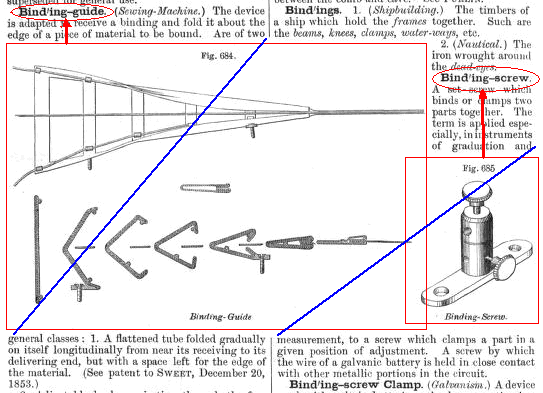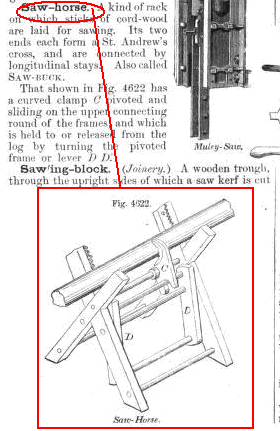
Most columns read straightforwardly from top to bottom; and most illustrations appear in the entry which they illustrate. But many do not, and others can be a bit ambiguous.
In the example below, the illustrations appear in the correct place, but one has to check the captions to make sure that this is true. The picture of the binding-guide belongs in the entry for "Binding-guide" and the picture of the binding-screw belongs in the entry for "Binding-screw". And the columns proceed from top to bottom across the illustrations, as one would expect. But it doesn't hurt to check that this is the case:

In the example below, the illustration for an entry is printed on the page following the text of the entry, but still needs to be kept included within the entry.
| Sample | Transcription |
|---|---|
 |
<E>
<HW>Bin`na-cle.</HW> <DEF><P>(Fr. <I>habittacle</I>) <LABEL>Nautical.</LABEL> A case or box for containing the compass of a ship and a light by which it is illuminated at night.</P> <P>It is placed immediately in front of the wheel or steering-apparatus, and secured to the deck, usually, by metal stays. The after portion has glass windows, so that the compass is at all times visible to the helmsman, who stands at the wheel.</P> <PB REF="313" N="285" HEAD="BINOCLE. BINOCULAR MICROSCOPE."> <FIGURE N="686"><HEAD>Binnacle.</HEAD></FIGURE> </DEF> </E> <E> <HW>Bin`o-cle</HW> <DEF> <P><LABEL>Optics.</LABEL> A <REF>BINOCULAR TELESCOPE</REF> (which see).</P> </DEF> </E> <E> <HW>Bi-noc`u-lar Eye-piece</HW> <DEF> <P>One in which the eye-piece is so constructed and applied to the object-glass as to divide the optical pencil transmitted to the latter, and form, as to each part of the divided pencil, a real or virtual image of the object beyond the place of division.</P> <FIGURE N="687"><HEAD>Eye-Piece for Optical Instruments.</HEAD></FIGURE> </DEF> </E> |
| (on next page)
|
In the example below, the picture of the saw-horse is not printed within the entry for "Saw-horse": it needs to be moved so that it appears within the correct entry (tucking <FIGURE N="4622"><HEAD>Saw-Horse.</HEAD></FIGURE> at the end of the last <P> of the <DEF> will do fine).

In the example below, the illustration headed "Medicinal Bath" needs to be moved into the entry for "Medicinal Bath." Placing the <FIGURE> tag at the beginning of the <DEF> will work fine, as indicated by the sample capture.
|
SAMPLE
|
Transcription
<E><HW>Me-dic`i-nal Bath.</HW>
|
In the example below, the entry for "beveling-machine" (with its accompanying illustration) begins in the left column, but is continued in the righthand column, followed by the entries for "bevel plumb-rule" and "bevel scroll-saw"; the latter (after its accompanying illustration) is continued back in the lefthand column again, followed in the lefthand column by the entr for "bevel-square", which finishes the lefthand column and is continued in the righthand column.
|
Sample.
|
|
Transcription (partial).
<E>
|